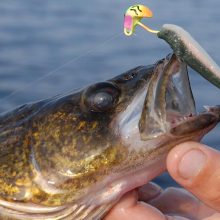This article may contain affiliate links. If you make a purchase after clicking on a link we may earn a small commission at no extra cost to you. As an Amazon Associate, I earn from qualifying purchases.
Walleye Tackle and Fishing Gear

There are a lot of different ways to catch walleye and unfortunately that means tailoring your walleye tackle and gear to the specific technique you are using.
Trolling gear will be useless for ice fishing and a jigging setup won’t work be strong enough when using divers and down-riggers and vice versa.
If you fish for walleye year round then you will end up fishing one of the major techniques at a specific point:
- Jigging – lighter rods with a fast action usually a spinning setup
- Ice fishing – very short ice fishing rods and reels
- Spinning/casting – throwing lures or jigs into cover or structure
- Trolling – heavier setup using planer boards, down-riggers or weighted rigs to fine tune depth
Walleye Tackle
Walleye fishing gear is quite diverse owing to the fact that there are several entirely different techniques that have very little crossover between the types of fishing gear that is used.
Your tackle will ultimately change with the seasons in some form or another.
1. Jigging
Using a Jig for walleye is one of the most popular techniques. Whether that’s using small spoons or walleye jigs the tackle really needs to give you the most feedback possible through the rod.
Most walleye rods for this style of fishing will have a fast action, a medium/light power rating and be roughly 6.5 feet in length, this is a pretty standard walleye jigging setup.
A fast action means that the natural bend in the rod will start higher up in the top one third of the rod blank.
This means a quicker snappier jig action and a lot more feel is transmitted from the line to the rod.
Fishing line will either be fluorocarbon or braid as your main line and a fluorocarbon leader or roughly six feet.
Monofilament is a bad choice when using walleye jigs as there is too much natural stretch in it.
That added stretch is kill the sensitivity of the rod as you loose a lot of feedback.
2. Ice Fishing
When ice fishing the gear changes completely over to very short and light rods. A long rod is a hindrance when fishing over an ice hole.
When choosing an ice fishing line for walleye it is better to to stick to the specialty ice fishing lines that are designed specifically for it.
You need a line that is extremely abrasion resistant and one that stills remains pliable even in very cold temperatures.
The majority of walleye ice fishing lures will be jigs as vertical jigging or a light bait rig is your best option.
3. Casting Lures
If you like to cast lures out from bank when walleye fishing from the shore or if you like to stop your boat and cast at structures or deep cover then either a good spinning setup or a casting setup is needed.
You can use the same rod and reel as you do for jigging, the only issue is that it may not be able to handle really big lures.
A medium power rod with a fast action in either a spinning or baitcasting variation works just fine.
4. Trolling
When walleye trolling the constant drag puts a lot of strain on your gear especially if you are running down-riggers or planer boards.
Both add a lot of pressure to your line albeit in different ways.
A good trolling rod and reel is essential particularly if you like to troll deep.
When trolling spoons for walleye for example you may do so at great depths and at a faster speed than other types of lures which will put a lot of pressure on your gear.
When shallow water trolling you can use a lighter setup and I see quite a few anglers using a spinning reel but personally speaking I find spinning reel too awkward when trolling.
Line counter reels are a nice to have but not essential.
With so much variation in walleye fishing gear available a beginner might be a little overwhelmed.
The best bet is to choose one summer technique and an ice fishing setup if your intention is to fish year round.
Using a jig is probably the easiest tactic to master when you are starting out. You can also use the same tackle for casting lighter lures.
